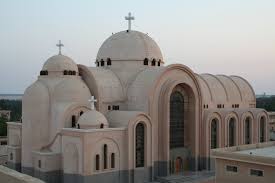
The monastery was founded by Saint Beshoy in the 4th century. Like the other buildings in the area, it suffered the attacks of the desert nomads and was restored several times. The monastery has a well-built tower and a wall of about 10 meters high and two meters thick, with two doors in the north and south sides. Within its compound, the monastery comprises a big garden, a mill, a well, a residence for the Patriarch Shenouda III, a number of cells for the monks, 5 churches, and 3 refectories (one of which was converted to a museum). The churches of the monastery are: Church of St. Michaels, Church of Saint Beshoy, Church of Abu Iskhirun, Church of the Holy Virgin, and the Church of Saint George. Today, the Church of Saint George, built in the 11th century, is not in use. It has two sanctuaries and six cupolas. The Church of the Holy Virgin, actually dedicated to Benjamin I, has a vaulted ceiling, a squared sanctuary, separated by a finely worked wooden iconostasis, and a dome. Built in the 11th century, the Church of Abu Iskhirun has a squared plan and a semi-circular apse where the sanctuary– separated by wooden iconostasis– lies. Under the church's altar are preserved the relics of Saint Iskhirun. The Church also contains a baptistery, beside the sanctuary. The Church of Saint Michaels has some icons that represent the twelve apostles. The main church of the monastery is the church of Saint Beshoy. Almost completely restored in the 14th century by Patriarch Benjamin II, the church consists of a three-aisled nave, a choir, and three sanctuaries dedicated to the Virgin (in the north side), Saint Beshoy (in the middle) and Saint John the Little (in the southern side). The wooden works of the doors, the pulpit and iconostasis are finely elaborated. The relics of many saints –like Saint Beshoy, Saint Paul of Tamya, and Patriarch Benjamin II– are preserved in the church.
